+ Open data
Open data
- Basic information
Basic information
| Entry | Database: PDB / ID: 8qyl | |||||||||||||||
|---|---|---|---|---|---|---|---|---|---|---|---|---|---|---|---|---|
| Title | Human 20S proteasome assembly intermediate structure 2 | |||||||||||||||
 Components Components |
| |||||||||||||||
 Keywords Keywords |  HYDROLASE / HYDROLASE /  Complex Complex | |||||||||||||||
| Function / homology |  Function and homology information Function and homology informationcerebellar granule cell precursor proliferation / purine ribonucleoside triphosphate binding / protein folding chaperone complex /  regulation of endopeptidase activity / Regulation of ornithine decarboxylase (ODC) / proteasome core complex / Cross-presentation of soluble exogenous antigens (endosomes) / regulation of endopeptidase activity / Regulation of ornithine decarboxylase (ODC) / proteasome core complex / Cross-presentation of soluble exogenous antigens (endosomes) /  Somitogenesis / proteasome core complex assembly / Somitogenesis / proteasome core complex assembly /  immune system process ...cerebellar granule cell precursor proliferation / purine ribonucleoside triphosphate binding / protein folding chaperone complex / immune system process ...cerebellar granule cell precursor proliferation / purine ribonucleoside triphosphate binding / protein folding chaperone complex /  regulation of endopeptidase activity / Regulation of ornithine decarboxylase (ODC) / proteasome core complex / Cross-presentation of soluble exogenous antigens (endosomes) / regulation of endopeptidase activity / Regulation of ornithine decarboxylase (ODC) / proteasome core complex / Cross-presentation of soluble exogenous antigens (endosomes) /  Somitogenesis / proteasome core complex assembly / Somitogenesis / proteasome core complex assembly /  immune system process / immune system process /  myofibril / myofibril /  proteasome binding / mitotic spindle assembly checkpoint signaling / proteasome binding / mitotic spindle assembly checkpoint signaling /  NF-kappaB binding / NF-kappaB binding /  proteasome assembly / chaperone-mediated protein complex assembly / proteasome assembly / chaperone-mediated protein complex assembly /  proteasome endopeptidase complex / proteasome core complex, beta-subunit complex / proteasome core complex, alpha-subunit complex / threonine-type endopeptidase activity / negative regulation of inflammatory response to antigenic stimulus / proteasome endopeptidase complex / proteasome core complex, beta-subunit complex / proteasome core complex, alpha-subunit complex / threonine-type endopeptidase activity / negative regulation of inflammatory response to antigenic stimulus /  proteasome complex / proteolysis involved in protein catabolic process / proteasome complex / proteolysis involved in protein catabolic process /  sarcomere / Regulation of activated PAK-2p34 by proteasome mediated degradation / Autodegradation of Cdh1 by Cdh1:APC/C / APC/C:Cdc20 mediated degradation of Securin / Asymmetric localization of PCP proteins / SCF-beta-TrCP mediated degradation of Emi1 / NIK-->noncanonical NF-kB signaling / Ubiquitin-dependent degradation of Cyclin D / AUF1 (hnRNP D0) binds and destabilizes mRNA / TNFR2 non-canonical NF-kB pathway / Assembly of the pre-replicative complex / Vpu mediated degradation of CD4 / Degradation of DVL / proteasomal protein catabolic process / sarcomere / Regulation of activated PAK-2p34 by proteasome mediated degradation / Autodegradation of Cdh1 by Cdh1:APC/C / APC/C:Cdc20 mediated degradation of Securin / Asymmetric localization of PCP proteins / SCF-beta-TrCP mediated degradation of Emi1 / NIK-->noncanonical NF-kB signaling / Ubiquitin-dependent degradation of Cyclin D / AUF1 (hnRNP D0) binds and destabilizes mRNA / TNFR2 non-canonical NF-kB pathway / Assembly of the pre-replicative complex / Vpu mediated degradation of CD4 / Degradation of DVL / proteasomal protein catabolic process /  P-body / Ubiquitin Mediated Degradation of Phosphorylated Cdc25A / Dectin-1 mediated noncanonical NF-kB signaling / Hh mutants are degraded by ERAD / Cdc20:Phospho-APC/C mediated degradation of Cyclin A / Degradation of AXIN / Defective CFTR causes cystic fibrosis / Degradation of GLI1 by the proteasome / P-body / Ubiquitin Mediated Degradation of Phosphorylated Cdc25A / Dectin-1 mediated noncanonical NF-kB signaling / Hh mutants are degraded by ERAD / Cdc20:Phospho-APC/C mediated degradation of Cyclin A / Degradation of AXIN / Defective CFTR causes cystic fibrosis / Degradation of GLI1 by the proteasome /  lipopolysaccharide binding / Activation of NF-kappaB in B cells / Hedgehog ligand biogenesis / Negative regulation of NOTCH4 signaling / G2/M Checkpoints / GSK3B and BTRC:CUL1-mediated-degradation of NFE2L2 / Autodegradation of the E3 ubiquitin ligase COP1 / Vif-mediated degradation of APOBEC3G / Hedgehog 'on' state / Regulation of RUNX3 expression and activity / Degradation of GLI2 by the proteasome / GLI3 is processed to GLI3R by the proteasome / MAPK6/MAPK4 signaling / FBXL7 down-regulates AURKA during mitotic entry and in early mitosis / response to virus / APC/C:Cdh1 mediated degradation of Cdc20 and other APC/C:Cdh1 targeted proteins in late mitosis/early G1 / ABC-family proteins mediated transport / Degradation of beta-catenin by the destruction complex / Oxygen-dependent proline hydroxylation of Hypoxia-inducible Factor Alpha / CDK-mediated phosphorylation and removal of Cdc6 / CLEC7A (Dectin-1) signaling / SCF(Skp2)-mediated degradation of p27/p21 / lipopolysaccharide binding / Activation of NF-kappaB in B cells / Hedgehog ligand biogenesis / Negative regulation of NOTCH4 signaling / G2/M Checkpoints / GSK3B and BTRC:CUL1-mediated-degradation of NFE2L2 / Autodegradation of the E3 ubiquitin ligase COP1 / Vif-mediated degradation of APOBEC3G / Hedgehog 'on' state / Regulation of RUNX3 expression and activity / Degradation of GLI2 by the proteasome / GLI3 is processed to GLI3R by the proteasome / MAPK6/MAPK4 signaling / FBXL7 down-regulates AURKA during mitotic entry and in early mitosis / response to virus / APC/C:Cdh1 mediated degradation of Cdc20 and other APC/C:Cdh1 targeted proteins in late mitosis/early G1 / ABC-family proteins mediated transport / Degradation of beta-catenin by the destruction complex / Oxygen-dependent proline hydroxylation of Hypoxia-inducible Factor Alpha / CDK-mediated phosphorylation and removal of Cdc6 / CLEC7A (Dectin-1) signaling / SCF(Skp2)-mediated degradation of p27/p21 /  nuclear matrix / Regulation of expression of SLITs and ROBOs / FCERI mediated NF-kB activation / Regulation of PTEN stability and activity / Interleukin-1 signaling / Orc1 removal from chromatin / Regulation of RAS by GAPs / Separation of Sister Chromatids / Regulation of RUNX2 expression and activity / UCH proteinases / The role of GTSE1 in G2/M progression after G2 checkpoint / KEAP1-NFE2L2 pathway / Antigen processing: Ubiquitination & Proteasome degradation / Downstream TCR signaling / nuclear matrix / Regulation of expression of SLITs and ROBOs / FCERI mediated NF-kB activation / Regulation of PTEN stability and activity / Interleukin-1 signaling / Orc1 removal from chromatin / Regulation of RAS by GAPs / Separation of Sister Chromatids / Regulation of RUNX2 expression and activity / UCH proteinases / The role of GTSE1 in G2/M progression after G2 checkpoint / KEAP1-NFE2L2 pathway / Antigen processing: Ubiquitination & Proteasome degradation / Downstream TCR signaling /  Neddylation / RUNX1 regulates transcription of genes involved in differentiation of HSCs / positive regulation of NF-kappaB transcription factor activity / ER-Phagosome pathway / Neddylation / RUNX1 regulates transcription of genes involved in differentiation of HSCs / positive regulation of NF-kappaB transcription factor activity / ER-Phagosome pathway /  regulation of inflammatory response / postsynapse / proteasome-mediated ubiquitin-dependent protein catabolic process / secretory granule lumen / regulation of inflammatory response / postsynapse / proteasome-mediated ubiquitin-dependent protein catabolic process / secretory granule lumen /  endopeptidase activity / ficolin-1-rich granule lumen / molecular adaptor activity / endopeptidase activity / ficolin-1-rich granule lumen / molecular adaptor activity /  nuclear body / nuclear body /  ribosome / Ub-specific processing proteases / nuclear speck / intracellular membrane-bounded organelle / ribosome / Ub-specific processing proteases / nuclear speck / intracellular membrane-bounded organelle /  centrosome / centrosome /  synapse / synapse /  ubiquitin protein ligase binding ubiquitin protein ligase bindingSimilarity search - Function | |||||||||||||||
| Biological species |   Homo sapiens (human) Homo sapiens (human) | |||||||||||||||
| Method |  ELECTRON MICROSCOPY / ELECTRON MICROSCOPY /  single particle reconstruction / single particle reconstruction /  cryo EM / Resolution: 2.67 Å cryo EM / Resolution: 2.67 Å | |||||||||||||||
 Authors Authors | Schulman, B.A. / Hanna, J.W. / Harper, J.W. / Adolf, F. / Du, J. / Rawson, S.D. / Walsh Jr, R.M. / Goodall, E.A. | |||||||||||||||
| Funding support |  Germany, Germany,  United States, 4items United States, 4items
| |||||||||||||||
 Citation Citation |  Journal: Nat Struct Mol Biol / Year: 2024 Journal: Nat Struct Mol Biol / Year: 2024Title: Visualizing chaperone-mediated multistep assembly of the human 20S proteasome. Authors: Frank Adolf / Jiale Du / Ellen A Goodall / Richard M Walsh / Shaun Rawson / Susanne von Gronau / J Wade Harper / John Hanna / Brenda A Schulman /   Abstract: Dedicated assembly factors orchestrate the stepwise production of many molecular machines, including the 28-subunit proteasome core particle (CP) that mediates protein degradation. Here we report ...Dedicated assembly factors orchestrate the stepwise production of many molecular machines, including the 28-subunit proteasome core particle (CP) that mediates protein degradation. Here we report cryo-electron microscopy reconstructions of seven recombinant human subcomplexes that visualize all five chaperones and the three active site propeptides across a wide swath of the assembly pathway. Comparison of these chaperone-bound intermediates and a matching mature CP reveals molecular mechanisms determining the order of successive subunit additions, as well as how proteasome subcomplexes and assembly factors structurally adapt upon progressive subunit incorporation to stabilize intermediates, facilitate the formation of subsequent intermediates and ultimately rearrange to coordinate proteolytic activation with gated access to active sites. This work establishes a methodologic approach for structural analysis of multiprotein complex assembly intermediates, illuminates specific functions of assembly factors and reveals conceptual principles underlying human proteasome biogenesis, thus providing an explanation for many previous biochemical and genetic observations. #1: Journal: bioRxiv / Year: 2024 Title: Visualizing chaperone-mediated multistep assembly of the human 20S proteasome. Authors: Frank Adolf / Jiale Du / Ellen A Goodall / Richard M Walsh / Shaun Rawson / Susanne von Gronau / J Wade Harper / John Hanna / Brenda A Schulman /   Abstract: Dedicated assembly factors orchestrate stepwise production of many molecular machines, including the 28-subunit proteasome core particle (CP) that mediates protein degradation. Here, we report cryo- ...Dedicated assembly factors orchestrate stepwise production of many molecular machines, including the 28-subunit proteasome core particle (CP) that mediates protein degradation. Here, we report cryo-EM reconstructions of seven recombinant human subcomplexes that visualize all five chaperones and the three active site propeptides across a wide swath of the assembly pathway. Comparison of these chaperone-bound intermediates and a matching mature CP reveals molecular mechanisms determining the order of successive subunit additions, and how proteasome subcomplexes and assembly factors structurally adapt upon progressive subunit incorporation to stabilize intermediates, facilitate the formation of subsequent intermediates, and ultimately rearrange to coordinate proteolytic activation with gated access to active sites. The structural findings reported here explain many previous biochemical and genetic observations. This work establishes a methodologic approach for structural analysis of multiprotein complex assembly intermediates, illuminates specific functions of assembly factors, and reveals conceptual principles underlying human proteasome biogenesis. | |||||||||||||||
| History |
|
- Structure visualization
Structure visualization
| Structure viewer | Molecule:  Molmil Molmil Jmol/JSmol Jmol/JSmol |
|---|
- Downloads & links
Downloads & links
- Download
Download
| PDBx/mmCIF format |  8qyl.cif.gz 8qyl.cif.gz | 479.4 KB | Display |  PDBx/mmCIF format PDBx/mmCIF format |
|---|---|---|---|---|
| PDB format |  pdb8qyl.ent.gz pdb8qyl.ent.gz | 382.9 KB | Display |  PDB format PDB format |
| PDBx/mmJSON format |  8qyl.json.gz 8qyl.json.gz | Tree view |  PDBx/mmJSON format PDBx/mmJSON format | |
| Others |  Other downloads Other downloads |
-Validation report
| Arichive directory |  https://data.pdbj.org/pub/pdb/validation_reports/qy/8qyl https://data.pdbj.org/pub/pdb/validation_reports/qy/8qyl ftp://data.pdbj.org/pub/pdb/validation_reports/qy/8qyl ftp://data.pdbj.org/pub/pdb/validation_reports/qy/8qyl | HTTPS FTP |
|---|
-Related structure data
| Related structure data |  18757MC 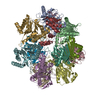 8qyjC 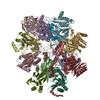 8qymC 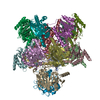 8qynC 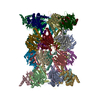 8qyoC 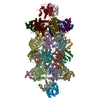 8qysC 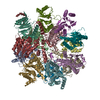 8qz9C M: map data used to model this data C: citing same article ( |
|---|---|
| Similar structure data | Similarity search - Function & homology  F&H Search F&H Search |
- Links
Links
- Assembly
Assembly
| Deposited unit | 
|
|---|---|
| 1 |
|
- Components
Components
-Proteasome subunit alpha type- ... , 7 types, 7 molecules ABCDEFG
| #1: Protein |  / Macropain subunit C3 / Multicatalytic endopeptidase complex subunit C3 / Proteasome component C3 / Macropain subunit C3 / Multicatalytic endopeptidase complex subunit C3 / Proteasome component C3Mass: 25927.535 Da / Num. of mol.: 1 Source method: isolated from a genetically manipulated source Source: (gene. exp.)   Homo sapiens (human) / Gene: PSMA2, HC3, PSC3 / Production host: Homo sapiens (human) / Gene: PSMA2, HC3, PSC3 / Production host:   Trichoplusia ni (cabbage looper) / References: UniProt: P25787 Trichoplusia ni (cabbage looper) / References: UniProt: P25787 |
|---|---|
| #2: Protein |  / Macropain subunit C9 / Multicatalytic endopeptidase complex subunit C9 / Proteasome component C9 / ...Macropain subunit C9 / Multicatalytic endopeptidase complex subunit C9 / Proteasome component C9 / Proteasome subunit L / Macropain subunit C9 / Multicatalytic endopeptidase complex subunit C9 / Proteasome component C9 / ...Macropain subunit C9 / Multicatalytic endopeptidase complex subunit C9 / Proteasome component C9 / Proteasome subunit LMass: 29525.842 Da / Num. of mol.: 1 Source method: isolated from a genetically manipulated source Source: (gene. exp.)   Homo sapiens (human) / Gene: PSMA4, HC9, PSC9 / Production host: Homo sapiens (human) / Gene: PSMA4, HC9, PSC9 / Production host:   Trichoplusia ni (cabbage looper) / References: UniProt: P25789 Trichoplusia ni (cabbage looper) / References: UniProt: P25789 |
| #3: Protein |  / Proteasome subunit RC6-1 / Proteasome subunit XAPC7 / Proteasome subunit RC6-1 / Proteasome subunit XAPC7Mass: 27929.891 Da / Num. of mol.: 1 Source method: isolated from a genetically manipulated source Source: (gene. exp.)   Homo sapiens (human) / Gene: PSMA7, HSPC / Production host: Homo sapiens (human) / Gene: PSMA7, HSPC / Production host:   Trichoplusia ni (cabbage looper) / References: UniProt: O14818 Trichoplusia ni (cabbage looper) / References: UniProt: O14818 |
| #4: Protein |  / Macropain zeta chain / Multicatalytic endopeptidase complex zeta chain / Proteasome zeta chain / Macropain zeta chain / Multicatalytic endopeptidase complex zeta chain / Proteasome zeta chainMass: 26462.016 Da / Num. of mol.: 1 Source method: isolated from a genetically manipulated source Source: (gene. exp.)   Homo sapiens (human) / Gene: PSMA5 / Production host: Homo sapiens (human) / Gene: PSMA5 / Production host:   Trichoplusia ni (cabbage looper) / References: UniProt: P28066 Trichoplusia ni (cabbage looper) / References: UniProt: P28066 |
| #5: Protein |  Mass: 29621.662 Da / Num. of mol.: 1 Source method: isolated from a genetically manipulated source Source: (gene. exp.)   Homo sapiens (human) / Gene: PSMA1 / Production host: Homo sapiens (human) / Gene: PSMA1 / Production host:   Trichoplusia ni (cabbage looper) / References: UniProt: P25786 Trichoplusia ni (cabbage looper) / References: UniProt: P25786 |
| #6: Protein |  / Macropain subunit C8 / Multicatalytic endopeptidase complex subunit C8 / Proteasome component C8 / Macropain subunit C8 / Multicatalytic endopeptidase complex subunit C8 / Proteasome component C8Mass: 28469.252 Da / Num. of mol.: 1 Source method: isolated from a genetically manipulated source Source: (gene. exp.)   Homo sapiens (human) / Gene: PSMA3, HC8, PSC8 / Production host: Homo sapiens (human) / Gene: PSMA3, HC8, PSC8 / Production host:   Trichoplusia ni (cabbage looper) / References: UniProt: P25788 Trichoplusia ni (cabbage looper) / References: UniProt: P25788 |
| #7: Protein |  / 27 kDa prosomal protein / p27K / Macropain iota chain / Multicatalytic endopeptidase complex iota ...27 kDa prosomal protein / p27K / Macropain iota chain / Multicatalytic endopeptidase complex iota chain / Proteasome iota chain / 27 kDa prosomal protein / p27K / Macropain iota chain / Multicatalytic endopeptidase complex iota ...27 kDa prosomal protein / p27K / Macropain iota chain / Multicatalytic endopeptidase complex iota chain / Proteasome iota chainMass: 27432.459 Da / Num. of mol.: 1 Source method: isolated from a genetically manipulated source Source: (gene. exp.)   Homo sapiens (human) / Gene: PSMA6, PROS27 / Production host: Homo sapiens (human) / Gene: PSMA6, PROS27 / Production host:   Trichoplusia ni (cabbage looper) / References: UniProt: P60900 Trichoplusia ni (cabbage looper) / References: UniProt: P60900 |
-Protein , 1 types, 1 molecules H
| #8: Protein | Mass: 15804.993 Da / Num. of mol.: 1 Source method: isolated from a genetically manipulated source Source: (gene. exp.)   Homo sapiens (human) / Gene: POMP, C13orf12, UMP1, HSPC014, HSPC036, PNAS-110 / Production host: Homo sapiens (human) / Gene: POMP, C13orf12, UMP1, HSPC014, HSPC036, PNAS-110 / Production host:   Trichoplusia ni (cabbage looper) / References: UniProt: Q9Y244 Trichoplusia ni (cabbage looper) / References: UniProt: Q9Y244 |
|---|
-Proteasome assembly chaperone ... , 2 types, 2 molecules IJ
| #9: Protein | Mass: 32891.887 Da / Num. of mol.: 1 Source method: isolated from a genetically manipulated source Source: (gene. exp.)   Homo sapiens (human) / Gene: PSMG1, C21LRP, DSCR2, PAC1 / Production host: Homo sapiens (human) / Gene: PSMG1, C21LRP, DSCR2, PAC1 / Production host:   Trichoplusia ni (cabbage looper) / References: UniProt: O95456 Trichoplusia ni (cabbage looper) / References: UniProt: O95456 |
|---|---|
| #10: Protein | Mass: 29449.080 Da / Num. of mol.: 1 Source method: isolated from a genetically manipulated source Source: (gene. exp.)   Homo sapiens (human) / Gene: PSMG2 / Production host: Homo sapiens (human) / Gene: PSMG2 / Production host:   Trichoplusia ni (cabbage looper) / References: UniProt: Q969U7 Trichoplusia ni (cabbage looper) / References: UniProt: Q969U7 |
-Proteasome subunit beta type- ... , 2 types, 2 molecules KL
| #11: Protein |  Mass: 35490.406 Da / Num. of mol.: 1 Source method: isolated from a genetically manipulated source Details: Where the identity of amino acids cannot be confidently assign, these are modelled as unknown (UNK) Source: (gene. exp.)   Homo sapiens (human) / Gene: PSMB7 / Production host: Homo sapiens (human) / Gene: PSMB7 / Production host:   Trichoplusia ni (cabbage looper) / References: UniProt: Q99436 Trichoplusia ni (cabbage looper) / References: UniProt: Q99436 |
|---|---|
| #12: Protein |  PSMB3 / Proteasome chain 13 / Proteasome component C10-II / Proteasome theta chain PSMB3 / Proteasome chain 13 / Proteasome component C10-II / Proteasome theta chainMass: 22972.896 Da / Num. of mol.: 1 Source method: isolated from a genetically manipulated source Source: (gene. exp.)   Homo sapiens (human) / Gene: PSMB3 / Production host: Homo sapiens (human) / Gene: PSMB3 / Production host:   Trichoplusia ni (cabbage looper) Trichoplusia ni (cabbage looper)References: UniProt: P49720,  proteasome endopeptidase complex proteasome endopeptidase complex |
-Details
| Has ligand of interest | N |
|---|
-Experimental details
-Experiment
| Experiment | Method:  ELECTRON MICROSCOPY ELECTRON MICROSCOPY |
|---|---|
| EM experiment | Aggregation state: PARTICLE / 3D reconstruction method:  single particle reconstruction single particle reconstruction |
- Sample preparation
Sample preparation
| Component | Name: Human 20S proteasome assembly intermediate map 2 / Type: COMPLEX / Entity ID: all / Source: RECOMBINANT |
|---|---|
| Source (natural) | Organism:   Homo sapiens (human) Homo sapiens (human) |
| Source (recombinant) | Organism:   Trichoplusia ni (cabbage looper) Trichoplusia ni (cabbage looper) |
| Buffer solution | pH: 7.5 |
| Specimen | Embedding applied: NO / Shadowing applied: NO / Staining applied : NO / Vitrification applied : NO / Vitrification applied : YES : YES |
Vitrification | Cryogen name: ETHANE-PROPANE |
- Electron microscopy imaging
Electron microscopy imaging
| Experimental equipment |  Model: Titan Krios / Image courtesy: FEI Company |
|---|---|
| Microscopy | Model: FEI TITAN KRIOS |
| Electron gun | Electron source : :  FIELD EMISSION GUN / Accelerating voltage: 300 kV / Illumination mode: FLOOD BEAM FIELD EMISSION GUN / Accelerating voltage: 300 kV / Illumination mode: FLOOD BEAM |
| Electron lens | Mode: BRIGHT FIELD Bright-field microscopy / Nominal defocus max: 2600 nm / Nominal defocus min: 1000 nm Bright-field microscopy / Nominal defocus max: 2600 nm / Nominal defocus min: 1000 nm |
| Image recording | Electron dose: 66.9 e/Å2 / Film or detector model: GATAN K3 BIOQUANTUM (6k x 4k) |
- Processing
Processing
| EM software | Name: SerialEM / Category: image acquisition | ||||||||||||||||||||||||
|---|---|---|---|---|---|---|---|---|---|---|---|---|---|---|---|---|---|---|---|---|---|---|---|---|---|
CTF correction | Type: PHASE FLIPPING AND AMPLITUDE CORRECTION | ||||||||||||||||||||||||
3D reconstruction | Resolution: 2.67 Å / Resolution method: FSC 0.143 CUT-OFF / Num. of particles: 322874 / Symmetry type: POINT | ||||||||||||||||||||||||
| Refine LS restraints |
|
 Movie
Movie Controller
Controller












 PDBj
PDBj





